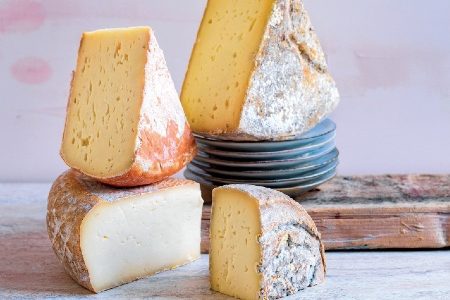What shape do the Alps have? That of the toma is one of them. From the pastures of Piedmont and Valle d’Aosta, which differ in seasoning and intensity, they can be recognized by a subtle bitter vein!
That the name derives from the archaic verb "tomare", to fall, referring to the breaking of the curd and the ease with which the casein (milk protein) coagulates and precipitates separating itself from the liquid component (whey), is only a hypothesis. The origin, however, is certain, linked to the use of milk after the spontaneous surfacing of the fat part and the collection of the cream to produce the butter. The cheese was therefore of the semi-fat type and the cooking temperature of the curd classifies it as semi-cooked pasta, because it does not exceed 40 degrees. These details, which might seem too technical, indicate how much attention the dairyman had to pay to reduce the spontaneous bacterial contamination of milk, without altering its coagulation capacity and the typical aromas of the finished product.
Encoded since 1996 by the Dop, the toma is produced throughout the Alpine and Piedmontese foothills area, while from the eastern part of the Aosta Valley, from the Gressoney valley, comes a raw milk rarity, produced mostly in the summer months, recognized as Pat (traditional food product) e Slow Food presidium.
During the maturing in cells, caves or malghe (on average for 30-40 days, from a minimum of 15 days to a maximum of 60), the rind must be washed from excessive microbial growth to achieve a color that, according to the maturation, goes from intense straw yellow to brown / reddish brown, giving the shapes (from 1.8 to 9 kilos) a rustic look; the paste has a beautiful white color with yellow hues and tiny holes evenly distributed.
The portioning of the toma is in wedges: so you can savor with the eyes, with the hand, with the nose and with the palate an evident elasticity, fragrant lactic aromas that in the Valdostane tomes are enriched with herbaceous notes sometimes balsamic and an intense taste, never intrusive.
Tome of the Gressoney Valley
Produced in mountain pasture, over 2000 meters, with semi-skimmed raw milk, after a minimum aging of 90 days, it is dark, with notes of herbs and stable.
The wine to match: Pinot Noir, Aosta Valley or South Tyrolean, aged in wood; more structured as the maturation of the toma increases.
Toma d Saint’Ours
Delicate and chewy, by pasteurized whole cow's milk, was invented by the Nicoletta di Donnas dairy for the Sant’Orso fair. The "reserve" version ages for over a year and a half.
The wine to match: Mountain red, young and acidulous, juicy, like Gamay from the Aosta Valley.
Toma of the Elvo Valley
Of skimmed milk, of soft dough. After aging from 60 to 120 days, it acquires an intense flavor.
The wine to match: Red, fresh and slightly spicy, like Coste della Sesia, a mix of Nebbiolo, Croatina and Vespolina, also from Biella.
Piedmontese Toma
Protected with the DOP, produced in the mountains and in the plains, ages from 20 to 45 days (over 60 that of the mountain pastures). TO cow milk, of elastic dough, it has different characteristics depending on the area of origin.
The wine to match: A white wine is also fine, for example a Chardonnay from the Langhe with a good structure and aged in wood.
This recipe has already been read 273 times!
